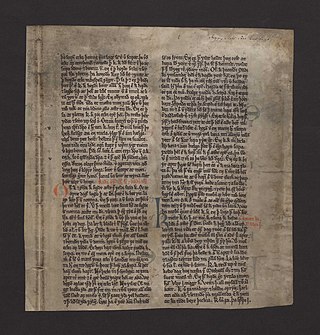
In Norse mythology, Brísingamen is the torc or necklace of the goddess Freyja. The name is an Old Norse compound brísinga-men whose second element is men "(ornamental) neck-ring, torc". The etymology of the first element is uncertain. It has been derived from Old Norse brísingr, a poetic term for "fire" or "amber" mentioned in the anonymous versified word-lists (þulur) appended to many manuscripts of the Prose Edda, making Brísingamen "gleaming torc", "sunny torc", or the like. However, Brísingr can also be an ethnonym, in which case Brísinga men is "torque of the Brísings"; the Old English parallel in Beowulf supports this derivation, though who the Brísings may have been remains unknown.

A Song of Ice and Fire is a series of epic fantasy novels by the American novelist and screenwriter George R. R. Martin. He began the first volume of the series, A Game of Thrones, in 1991, and it was published in 1996. Martin, who initially envisioned the series as a trilogy, has published five out of a planned seven volumes. The fifth and most recent volume of the series, A Dance with Dragons, was published in 2011, six years after the publication of the preceding book, A Feast for Crows. He is currently writing the sixth novel, The Winds of Winter. A seventh novel, A Dream of Spring, is planned.

Heimskringla is the best known of the Old Norse kings' sagas. It was written in Old Norse in Iceland by the poet and historian Snorri Sturluson (1178/79–1241) c. 1230. The name Heimskringla was first used in the 17th century, derived from the first two words of one of the manuscripts.

Olaf Tryggvason was King of Norway from 995 to 1000. He was the son of Tryggvi Olafsson, king of Viken, and, according to later sagas, the great-grandson of Harald Fairhair, first King of Norway. He is numbered as Olaf I.

Tafl games are a family of ancient Northern European strategy board games played on a checkered or latticed gameboard with two armies of uneven numbers. Most probably they are based upon the Roman game Ludus latrunculorum. Names of different variants of Tafl include Hnefatafl, Tablut, Tawlbwrdd, Brandubh, Ard Rí, and Alea Evangelii. Games in the tafl family were played in Norway, Sweden, Denmark, Iceland, Britain, Ireland, and Sápmi. Tafl gaming was eventually supplanted by chess in the 12th century, but the tafl variant of the Sámi people, tablut, was in play until at least the 18th century. The rules for tablut were written down by the Swedish naturalist Linnaeus in 1732, and these were translated from Latin to English in 1811. All modern tafl games are based on the 1811 translation, which had many errors. New rules were added to amend the issues resulting from these errors, leading to the creation of a modern family of tafl games. In addition, tablut is now also played in accordance with its original rules, which have been retranslated.

Olof Skötkonung, sometimes stylized as Olaf the Swede, was King of Sweden, son of Eric the Victorious and, according to Icelandic sources, Sigrid the Haughty. He succeeded his father in c. 995. He stands at the threshold of recorded history, since he is the first Swedish ruler about whom there is substantial knowledge. He is regarded as the first king known to have ruled both the Swedes and the Geats. In Sweden, the reign of king Olov Skötkonung is considered to be the transition from the Viking age to the Middle Ages, because he was the first Christian king of the Swedes, who were the last to adopt Christianity in Scandinavia. He is associated with a growing influence of the church in what is today southwestern and central Sweden. Norse beliefs persisted in parts of Sweden until the 12th century.

The Battle of Svolder was a large naval battle during the Viking age, fought in September 999 or 1000 in the western Baltic Sea between King Olaf of Norway and an alliance of the Kings of Denmark and Sweden and Olaf's enemies in Norway. The backdrop of the battle was the unification of Norway into a single independent state after longstanding Danish efforts to control the country, combined with the spread of Christianity in Scandinavia.
Erik Hakonsson, also known as Eric of Hlathir or Eric of Norway, was Earl of Lade, Governor of Norway and Earl of Northumbria. He was the son of Earl Hákon Sigurðarson and brother of the legendary Aud Haakonsdottir of Lade. He participated in the Battle of Hjörungavágr, the Battle of Svolder and the conquest of England by King Canute the Great.
Sigurd Syr was a Norwegian petty king of Ringerike, a region in Buskerud. He was notable in Norwegian history largely through his association with Kings Harald Hardrada and Olaf II of Norway. By his marriage with Åsta Gudbrandsdatter after her first husband Harald Grenske had died, Sigurd Syr was stepfather of King Olaf II and the father of King Harald III.

The Jomsvikings were purportedly a legendary order of Viking mercenaries or conquerors of the 10th and 11th centuries. Though reputed to be staunchly dedicated to the worship of the Old Norse gods, they would allegedly fight for any lord who could pay their substantial fees, even if they may be Christian. The institution of the Jomsvikings would itself foreshadow those of the later religious and chivalric orders of the Middle Ages.

The Fairhair dynasty was a family of kings founded by Harald I of Norway which united and ruled Norway with few interruptions from the latter half of the 9th century. In the traditional view, this lasted until 1387, however, many modern scholars view this rule as lasting only three generations, ending with Harald Greycloak in the late 10th century. The moniker "Fairhair dynasty" is a retrospective construction: in their lifetime what little traces there are refer to them consistently as "Ynglings".

Åsta Gudbrandsdatter was the mother of two Norwegian kings, King Olaf II of Norway and King Harald III of Norway. The primary source for the life of Åsta is Snorri Sturluson's saga Heimskringla, a 13th-century collection of tales about the lives of the Norwegian kings. In the chronicle, Åsta is described as "generous and high-minded" and as a keen political player and guiding influence on her royal husbands and children. Her parents were Gudbrand Kula and Ulfhild.

Joseph Edward Abercrombie is a British fantasy writer and film editor. He is the author of The First Law trilogy, as well as other fantasy books in the same setting and a trilogy of young adult novels. His novel Half a King won the 2015 Locus Award for best young adult book.

Gunnhildr konungamóðir or Gunnhildr Gormsdóttir, whose name is often Anglicised as Gunnhild is a quasi-historical figure who appears in the Icelandic Sagas, according to which she was the wife of Eric Bloodaxe. She appears prominently in sagas such as Fagrskinna, Egils saga, Njáls saga, and Heimskringla.
Robert Nicholas Low was a Scottish journalist and writer of historical fiction. His Oathsworn series of novels were set in the Viking Age.

The Whale Road is the first novel of the five-part Oathsworn series by Scottish writer of historical fiction, Robert Low, released on 1 August 2007 through Harper. The début novel was well received.

The Wolf Sea is the second novel of the five-part Oathsworn series by Scottish writer of historical fiction, Robert Low, released on 4 August 2008 through Harper. The novel was relatively well received.

The White Raven is the third novel of the five-part Oathsworn series by Scottish writer of historical fiction, Robert Low, released on 6 August 2009 through Harper. The novel was well received.

The Prow Beast is the fourth novel of the five-part Oathsworn series by Scottish writer of historical fiction, Robert Low, released on 5 August 2010 through Harper. The novel was well received.
A list of works by or about American historical novelist Cecelia Holland.
















